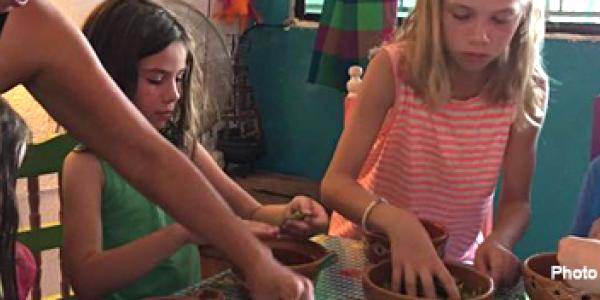How a Cooking Class Became a Lesson in Engaging Children

This summer, my family and I were fortunate enough to spend a week in Tulum, Mexico, with my best friend and her family—four adults and four kids (three under 8 years old) under one roof, enjoying the beautiful beaches, ruins, and jungles in the area.
On our second night in the country, we attended a cooking class. Having no idea what to expect, we drove to a neighborhood of colorful concrete houses with a multitude of cats and dogs roaming freely (amid a cacophony of barking and meowing), and chickens clucking in the background.
Lily, our teacher, welcomed us warmly to her home and introduced us to the five or six cats that wandered in and out of her house throughout our four hours with her. As we sat at her kitchen table breathing in wonderful fragrances coming from the stove and sweating profusely (air conditioning is a limited commodity in that region), she gave us an introduction to the history of food and cooking traditions in the region. Before she began this minilecture, though, she set a few bowls of peas that needed to be shelled in front of the children and put them to work, explaining that the peas would be used in a rice dish we would cook later in the evening. What a way to engage them quickly and to occupy their hands during the only passive part of the cooking lesson! After Lily finished her talk, she asked if we had any questions before we began cooking the meal. My son, 6 years old, raised his hand and asked, “Why does the orange cat only have three legs?” Lily didn’t seem to be at all fazed by this inquiry that wasn’t related to the foods she had just been describing. She answered frankly, sharing that neighborhood dogs had attacked the cat not too long ago. She then explained to the children that we couldn’t blame the dogs, because they were trained to be aggressive, and that the cat had since adapted to its disability. In such a simple way, she conveyed to the children concepts about the nature of animals, the influence of humans on animal behavior, and resilience in the face of disability. I was struck by how easily she did this and how receptive the kids were to her explanation.

A bit later in the class, one of the children became agitated and anxious to go home. Without a word, Lily hung a hammock across part of her kitchen and encouraged the child to relax in the hammock and swing herself. What a way to help a child calm herself! The hammock was frequently used by all of the kids throughout the rest of the evening. During our evening of cooking delicious foods, Lily constantly reassured us (the parents) that she was happy the children were part of the class and reminded us (as a mother who has two adult children) that it was natural for kids to be restless, curious, inquisitive, anxious, and easily distracted, and that she wasn’t perturbed by the occasional “I’m tired; can we go?” and “When are we going to eat?” that came from our children. (To be fair to them, we didn’t sit down to our meal until after 8:30 that evening.) Lily allowed them to come and go in the kitchen throughout the night, gave them jobs to do when they were there, and encouraged them to enjoy the patio with her many cats when they wanted a break.
While my friend and I are avid cooks, many of the dishes we made that night were new to the kids and included hot peppers and herbs and spices we don’t frequently cook with at home. As each dish was prepared, Lily asked the children to taste them—and, unlike at home, they willingly tried all of them without complaint and got a kick out of tasting and liking the super spicy dishes. Soon, they began an unspoken contest to see who could eat the most of the spicy food.
It was a very long night—none of us had anticipated that the class would be four hours long, without air conditioning, in the confines of a small space, and that we wouldn’t sit down to dinner until 8:30. But it was an incredible night. We left with a much richer understanding of the foods in the region, a great set of recipes to recreate back in the states, and a role model in Lily for finding ways to engage children’s interest and having the patience to accept and manage those aspects of our kids that can sometimes drive us nuts.
I think I’m going to get a hammock for my kitchen!
Mary Harrill is Senior Director of Higher Education at NAEYC and a food consumer and experimenter extraordinaire in her off-time.